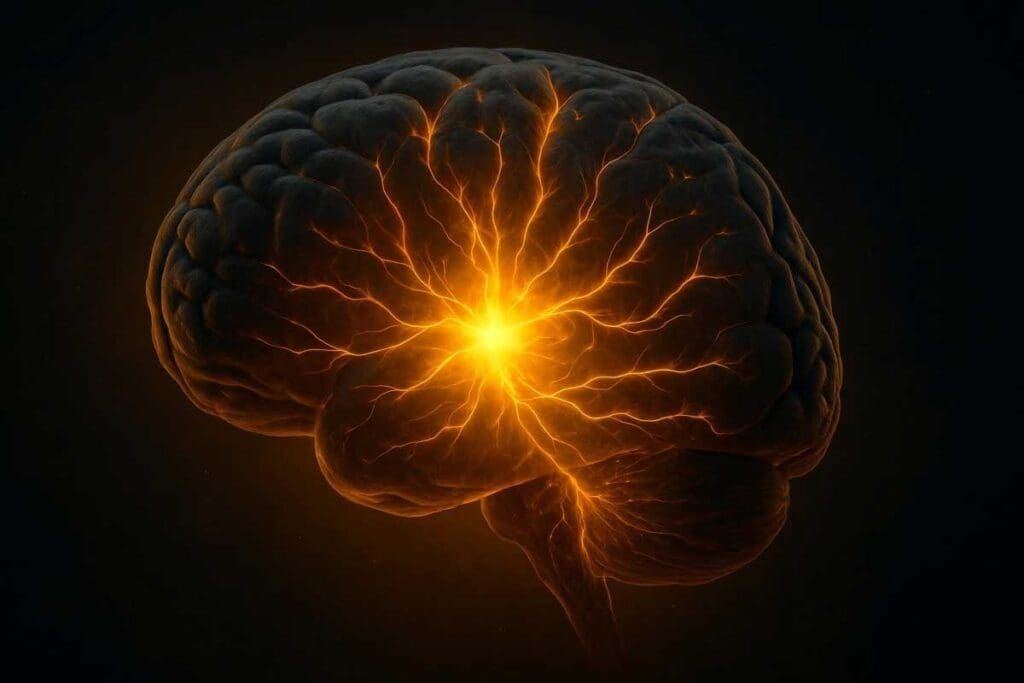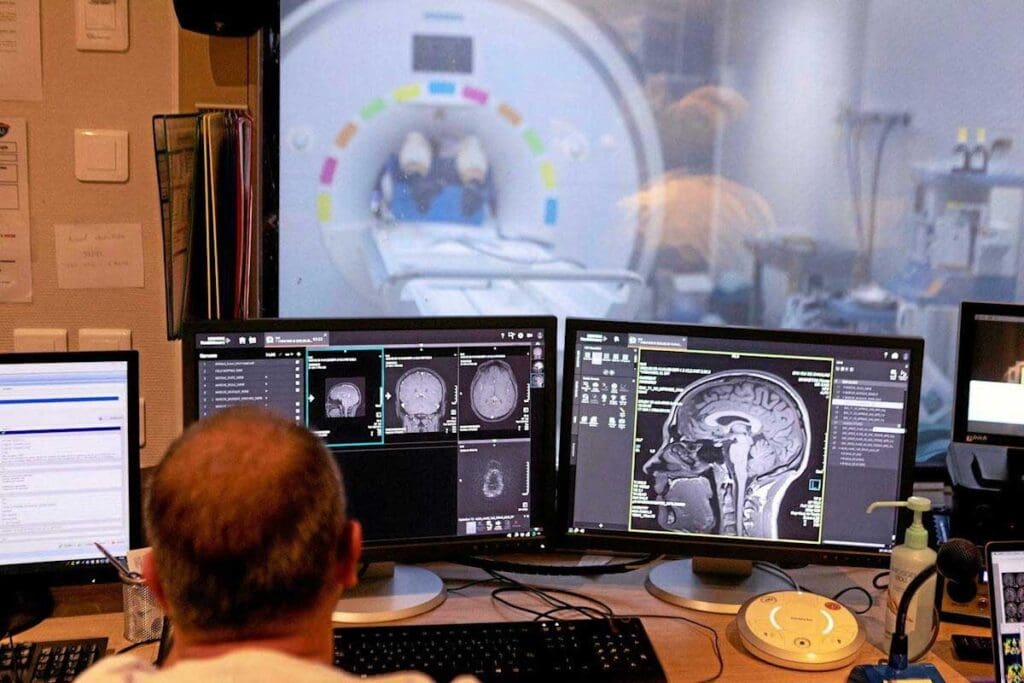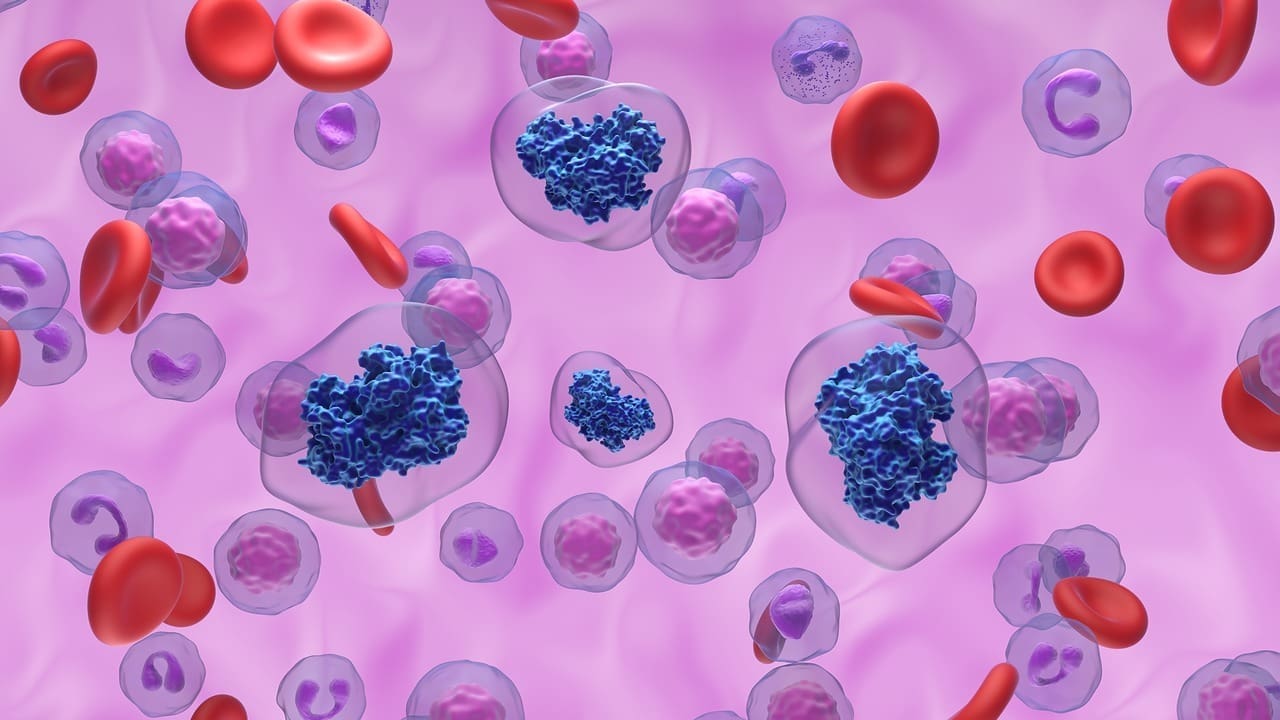Last Updated on November 27, 2025 by Bilal Hasdemir

At LivHospital, we know how key an accurate diagnosis is for treating Parkinson’s disease.Nm DaTscan, a cutting-edge dopamine brain scan, is vital. It helps see dopamine activity in the brain, which is key for diagnosing Parkinsonian syndromes.
DaTscan can tell Parkinson’s disease apart from other movement disorders with up to 90% accuracy. This makes it a top choice for doctors. By using DaTscan, we make sure diagnoses are right. This helps doctors make better choices for their patients with movement disorders.
Key Takeaways
- DaTscan is a nuclear medicine imaging test that visualizes dopamine transporter activity.
- It helps differentiate Parkinson’s disease from other Parkinsonian syndromes.
- DaTscan has a high accuracy rate of up to 90% in diagnosing Parkinson’s.
- The test supports clinical decision-making for movement disorders.
- Liv Hospital is committed to utilizing innovative diagnostic tools like DaTscan.
What Is DaTscan: The Advanced Dopamine Transporter Imaging Test

DaTscan, or dopamine transporter scan, is a cutting-edge imaging test. It helps diagnose Parkinson’s disease and other movement disorders. This tool uses a SPECT scanner and a special radiotracer to see dopamine activity in the brain.
The Science Behind Dopamine Transporter Visualization
The DaTscan uses a radiotracer that sticks to dopamine transporters in the brain. These transporters are on dopamine-releasing neurons and control dopamine levels. DaTscan lets doctors see how many dopamine neurons there are, which is key for diagnosing Parkinson’s disease.
Experts say DaTscan is a big step forward in diagnosing Parkinson’s. It helps doctors tell Parkinson’s apart from other movement disorders.
How DaTscan Differs from Other Brain Imaging Tests
DaTscan is different from MRI or CT scans because it shows dopamine activity. This helps doctors tell Parkinson’s apart from other conditions like essential tremor. DaTscan is great when it’s hard to figure out what’s wrong, giving a clear picture of dopamine neuron loss.
“The ability of DaTscan to detect loss of dopamine neurons makes it an invaluable tool in the diagnosis and management of Parkinson’s disease.” DaTscan is unique because it shows dopamine activity directly, unlike other imaging tests.
Key Fact 1: The NM DaTscan Procedure Explained

The NM DaTscan procedure is a detailed process. It helps doctors see how dopamine works in the brain. This test is key for diagnosing Parkinson’s disease and other movement disorders.
Patient Preparation and Radiotracer Injection
Before a DaTscan, patients must prepare in several ways. “Preparation is key to ensuring the success of the DaTscan procedure,” as it allows for optimal imaging and accurate results. Patients may need to stop taking certain medications that could interfere with the scan.
Once prepared, a small amount of a radioactive tracer, known as Ioflupane (123I), is injected into the patient’s bloodstream. This tracer binds to dopamine transporters in the brain, enabling the SPECT scanner to visualize the dopamine system.
The Scanning Process Using SPECT Technology
After the radiotracer has been allowed to circulate and bind to the dopamine transporters, the patient is positioned in the SPECT (Single Photon Emission Computed Tomography) scanner. The SPECT technology detects the gamma rays emitted by the tracer, creating detailed images of the brain’s dopamine transporter distribution. This process is non-invasive and relatively painless, taking approximately 15-30 minutes to complete.
As one expert notes, “The DaTscan procedure has revolutionized the way we diagnose and manage Parkinson’s disease, providing critical information that was previously unavailable.” The use of SPECT technology in DaTscan represents a significant advancement in nuclear medicine imaging.
Post-Procedure Care and Considerations
Following the scan, patients can typically resume their normal activities without restriction. The radioactive tracer is generally safe and is excreted from the body through natural processes. Patients are advised to drink plenty of fluids to help eliminate the tracer.
In some cases, patients may experience minor side effects, such as headache or nausea, but these are usually temporary and mild. The DaTscan procedure is considered safe and effective, with a high degree of accuracy in diagnosing Parkinson’s disease and related disorders. By understanding the steps involved in the DaTscan procedure, patients can better appreciate the diagnostic value of this advanced imaging test.
Key Fact 2: How DaTscan Detects Dopamine Neuron Loss
DaTscan technology has changed neurology by accurately finding dopamine neuron loss. It’s key to telling Parkinson’s disease apart from other movement disorders.
Normal vs. Abnormal DaTscan Results
Doctors look at DaTscan results to see if dopamine neurons are lost. Normal DaTscan results show a “comma-shaped” or “C-shaped” pattern in the striatum. But, abnormal results show less or uneven activity.
Abnormal scans often mean Parkinson’s disease or similar syndromes. The dDATscan helps by showing dopamine transporter density clearly.
Interpreting Striatal Binding Patterns
The striatal binding ratio is key in DaTscan analysis. It shows how much dopamine neuron loss there is. A low ratio means less dopamine activity, a sign of Parkinson’s disease.
| DaTscan Result | Striatal Binding Pattern | Clinical Implication |
| Normal | Comma-shaped or C-shaped | No significant dopamine neuron loss |
| Abnormal | Reduced or asymmetric | Possible Parkinson’s disease or Parkinsonian syndrome |
With the dopamine scan, doctors get important information on dopamine neurons. This helps in making the right diagnosis and treatment plans.
We use DaTscan to find dopamine neuron loss. It helps us tell Parkinson’s disease from other movement disorders. The data test neurology is a big help in our work.
Key Fact 3: Distinguishing Parkinson’s Disease from Essential Tremor
Distinguishing Parkinson’s disease from other movement disorders like essential tremor is tough. Symptoms can look similar, making it hard for doctors to make a correct diagnosis just by looking at the patient.
The Diagnostic Challenge of Movement Disorders
Movement disorders, such as Parkinson’s disease and essential tremor, are hard to diagnose because they share symptoms. Parkinson’s disease often shows tremors, rigidity, and slow movement. Essential tremor, on the other hand, is known for action tremors. But sometimes, essential tremor can also show rest tremors, making it tricky to tell them apart.
DaTscan’s Role in Differential Diagnosis
DaTscan helps tell Parkinson’s disease apart from essential tremor by showing dopamine levels in the brain. If DaTscan shows normal levels, it’s likely the patient doesn’t have Parkinson’s disease. This suggests they might have essential tremor or another condition.
DaTscan’s main benefits include:
- It accurately tells Parkinson’s disease apart from essential tremor.
- It shows dopamine levels in the brain.
- It supports doctors’ diagnoses with clear images.
A study in the Journal of Nuclear Medicine found that Tc-99m helps tell Parkinson’s disease from essential tremor. This helps doctors manage patients better.
| Diagnostic Feature | Parkinson’s Disease | Essential Tremor |
| DaTscan Result | Abnormal | Normal |
| Tremor Type | Rest tremor | Action tremor |
| Dopamine Transporter Density | Reduced | Normal |
Case Studies and Clinical Evidence
Many case studies and trials show DaTscan’s effectiveness in diagnosing Parkinson’s disease versus essential tremor. For example, a study mentioned in a
“DaTscan has changed how we diagnose and manage Parkinson’s disease. It brings clarity when the diagnosis is unsure.”
This shows DaTscan’s value in real-world use.
As research grows, DaTscan’s role in diagnosing becomes more critical. It gives doctors clear evidence of dopamine levels. This helps them make better decisions for patient care.
Key Fact 4: Limitations of DaTscan in Parkinson’s Diagnosis
DaTscan is very helpful, but it can’t confirm Parkinson’s disease alone. It shows how much dopamine is lost, but doctors need to look at symptoms and other tests too.
Why DaTscan Cannot Provide a Definitive Parkinson’s Diagnosis
DaTscan can’t tell Parkinson’s apart from other similar diseases. It’s not just for Parkinson’s; it spots dopamine loss in many diseases.
A study in the Journal of Nuclear Medicine says, “DaTscan is good at showing brain damage, but it’s not just for Parkinson’s.”
“The diagnosis of Parkinson’s disease remains clinical, supported by imaging findings.”
— Journal of Nuclear Medicine
Similar Patterns in Atypical Parkinsonian Syndromes
Other diseases like multiple system atrophy (MSA) and progressive supranuclear palsy (PSP) also show up on DaTscan. This makes it hard to tell them apart from Parkinson’s just by looking at the scan.
| Condition | DaTscan Result | Clinical Features |
| Parkinson’s Disease | Abnormal | Tremors, rigidity, bradykinesia |
| Multiple System Atrophy (MSA) | Abnormal | Autonomic dysfunction, Parkinsonism, cerebellar signs |
| Progressive Supranuclear Gaze (PSP) | Abnormal | Supranuclear gaze palsy, postural instability, Parkinsonism |
So, doctors must look at the whole picture, including the scan, to make a correct diagnosis.
In summary, DaTscan is a great tool, but it has its limits. By using it with other tests and the patient’s symptoms, doctors can give better care and treatment plans.
Key Fact 5: Clinical Scenarios Where DaTscan Is Most Valuable
DaTscan is key when symptoms are not clear. It gives doctors the info they need to make the right diagnosis. DaTscan shows dopamine levels in the brain, which is very helpful.
Unclear Symptoms and Examination Findings
When symptoms are not clear, like tremors, DaTscan can help. It can tell if the tremor is from Parkinson’s or another condition. This is important because treatments are different.
For example, a patient with tremors might get a DaTscan. The scan’s results help decide the next steps in treatment.
Early-Stage Diagnosis Considerations
In the early stages of Parkinson’s, symptoms are often not clear. DaTscan can provide valuable diagnostic information. It helps confirm or rule out Parkinson’s disease.
Early diagnosis is key to starting the right treatment. DaTscan plays a big role in this.
Monitoring Disease Progression
DaTscan is not just for diagnosis. It also helps track how the disease is progressing. It shows how much dopamine is lost, which helps understand the disease’s severity.
| Clinical Scenario | DaTscan’s Role | Benefit |
| Unclear Symptoms | Differentiates between Parkinson’s and other conditions | Guides treatment decisions |
| Early-Stage Diagnosis | Confirms or rules out Parkinson’s disease | Enables early treatment initiation |
| Disease Progression | Assesses dopamine transporter loss | Provides insights into disease severity |
Using DaTscan in these situations helps doctors make better choices. This leads to better care for patients.
Key Fact 6: Impact on Patient Management and Treatment Decisions
DaTscan results change how we manage and treat Parkinson’s disease. They give doctors a clear view of dopamine levels. This helps them make better decisions for patient care.
How DaTscan Results Change Diagnosis in Up to 68% of Cases
DaTscan results can change a diagnosis in up to 68% of cases. This is key when the diagnosis is unsure. It helps tell Parkinson’s disease apart from other movement disorders.
A change in diagnosis means better care for patients. It lets doctors create treatment plans that fit the patient’s needs. For example, a patient might get a new diagnosis after a DaTscan, changing their treatment.
Influence on Medication Selection and Dosing
DaTscan results help choose the right medicines and dosages. They show how much dopamine is present. This helps doctors pick the best treatments.
- More accurate diagnosis leads to targeted treatment plans
- Reduced risk of adverse reactions to unnecessary medications
- Improved patient outcomes through optimized medication dosing
Dr. [Last Name] says DaTscan is a big help in their practice. It helps them make better decisions for patient care and treatment.
“The use of DaTscan has significantly improved our ability to diagnose and manage Parkinson’s disease, leading to better patient outcomes.”
A Senior Neurologist
Patient Education and Long-term Planning
DaTscan results are also key for patient education and planning. They help patients understand their diagnosis and treatment options. This empowers them to be more involved in their care.
Doctors can explain the diagnosis, treatment choices, and how to manage symptoms. As we learn more about Parkinson’s disease and DaTscan, patient care will keep getting better.
Key Fact 7: Accuracy Rates and Research Advancements
DaTscan is a key tool in neurology, known for its high accuracy in diagnosing Parkinson’s disease. It has been studied a lot, showing its effectiveness and possible uses in medicine.
90% Accuracy in Differentiating Parkinson’s from Non-Dopaminergic Disorders
DaTscan is about 90% accurate in telling Parkinson’s disease apart from other disorders. This high accuracy is vital for giving the right treatment to patients. A study in the National Center for Biotechnology Information found DaTscan’s accuracy in diagnosing Parkinson’s to be consistently high.
DaTscan works by showing how much dopamine is in the brain. This helps doctors see if the brain’s dopamine system is working properly. It helps them tell Parkinson’s disease apart from other conditions with similar symptoms.
Recent Studies and Clinical Trials
New studies have shown DaTscan’s value in real-world use. For example, a big study found DaTscan made doctors more confident in their diagnoses. It also helped lower the number of wrong diagnoses and improved patient care.
Clinical trials have also looked at DaTscan’s role in tracking how diseases progress and how well treatments work. They found that changes in dopamine levels in the brain can show how severe a disease is. This could help DaTscan be used not just for diagnosis but also for tracking disease and treatment success.
Evolving Applications in Neurological Research
DaTscan is being used in more ways as research in neurology grows. It’s being studied for its use in other brain diseases and movement disorders. DaTscan’s ability to measure dopamine levels makes it a key tool for researchers studying brain diseases.
| Study | Year | Key Findings |
| PMC8144619 | 2021 | DaTscan showed high accuracy in diagnosing Parkinson’s disease |
| Multicenter Study | 2020 | DaTscan improved diagnostic accuracy and confidence among clinicians |
| Clinical Trial | 2019 | Changes in dopamine transporter binding correlated with clinical symptoms and disease severity |
As we learn more about brain diseases, DaTscan stays at the top of diagnostic technology. Its high accuracy and growing uses make it essential in both treating patients and researching diseases.
The DAT Scan Machine: Understanding the Technology
The DAT scan machine is a high-tech tool that uses SPECT technology. It shows how dopamine works in the brain. This is key for diagnosing and treating neurological disorders, like Parkinson’s disease.
SPECT Scanner Components and Function
The SPECT scanner is a key part of the DAT scan machine. It makes detailed images of dopamine activity in the brain. The scanner has a gamma camera that picks up gamma rays from the radiotracer in the patient’s blood.
The gamma camera moves around the patient’s head. It takes pictures from different angles. These pictures are then put together into a 3D image.
The SPECT scanner is great at finding gamma rays. This helps make clear images of dopamine activity. These images are important for diagnosing neurological disorders.
Radiotracer Development and Safety Profile
The radiotracer used in DaTscan imaging is very important. It’s made to be safe and work well. It attaches to dopamine transporters in the brain, showing where dopamine is active.
The safety of the radiotracer is checked carefully. It’s given in small amounts and has a short half-life. This means it doesn’t stay in the body for long. It’s also made to break down and leave the body quickly, reducing side effects.
Quality Control Measures in DaTscan Imaging
DaTscan imaging follows strict quality control steps. This includes keeping the SPECT scanner in top shape and training staff well. It also involves checking the radiotracer before use.
These steps help make sure DaTscan imaging is accurate and reliable. Healthcare providers can trust the results. This helps them make the best treatment plans for patients.
Conclusion: The Present and Future of DaTscan in Neurological Diagnosis
DaTscan technology has changed how we diagnose Parkinson’s disease and similar conditions. The nm datscan test helps doctors see how many dopamine neurons are lost. This is key in accurately diagnosing Parkinson’s disease.
Healthcare professionals use the DAT test for Parkinson’s to tell it apart from other conditions like essential tremor. This makes the diagnosis more precise.
DaTscan is a vital part of clinical practice today. Research shows it’s a reliable and accurate test. It greatly affects how doctors manage and treat patients.
We can look forward to DaTscan getting even better. Ongoing research and trials are exploring new uses for it in neurological disorders. As we learn more about Parkinson’s disease, DaTscan will keep being a key tool for diagnosis and treatment.
FAQ
What is a DaTscan, and how does it work?
DaTscan is a test that uses a special dye to see dopamine in the brain. It helps doctors find Parkinson’s disease and other movement disorders.
What is the DaTscan procedure like?
First, a dye is injected into the patient’s blood. Then, a scan takes pictures of the brain. After that, patients can go back to their usual activities.
How does DaTscan detect dopamine neuron loss?
DaTscan finds dopamine loss by attaching to dopamine transporters in the brain. This shows how dopamine is working. If it’s not right, it might mean Parkinson’s disease.
Can DaTscan diagnose Parkinson’s disease definitively?
No, DaTscan can’t say for sure if someone has Parkinson’s disease. It’s just one tool doctors use to help make a diagnosis.
What are the limitations of DaTscan in Parkinson’s diagnosis?
DaTscan can’t tell different diseases apart. This is because some diseases look similar on the scan.
In what clinical scenarios is DaTscan most valuable?
DaTscan is most useful when symptoms are unclear. It helps in early diagnosis and when differentiating Parkinson’s from other diseases.
How does DaTscan impact patient management and treatment decisions?
DaTscan results can change how patients are treated. They help choose the right medicine and plan for the future.
What is the accuracy rate of DaTscan in diagnosing Parkinson’s disease?
DaTscan is very accurate, about 90%. It’s good at telling Parkinson’s disease apart from other disorders.
What is the technology behind the DAT scan machine?
The DAT scan machine uses special parts and a dye to see the brain. It needs careful checks to work correctly.
Is DaTscan a relevant diagnostic tool in clinical practice?
Yes, DaTscan is very useful in doctors’ offices. It’s always getting better and helping with brain research and diagnosis.
References:
- Tay, Y. X., et al. (2025). Using evidence-based imaging referral guidelines to improve diagnosis and care. Journal of Medical Imaging and Radiation Oncology, 69(1), 73-81. https://pubmed.ncbi.nlm.nih.gov/39864244/






